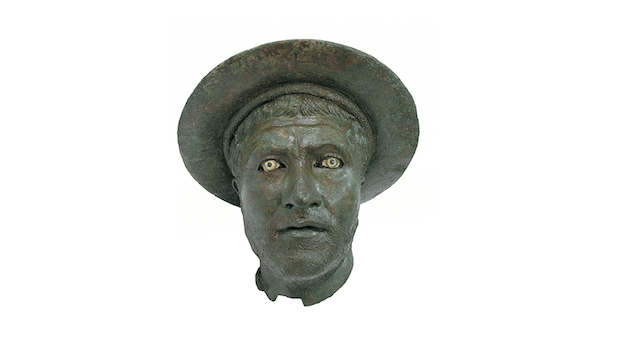For centuries there has been a note of yearning in our feelings about ancient Greek and Roman art. We can’t help mourning for what has irretrievably vanished. In 1764 Johann Joachim Winckelmann wrote that we have ‘nothing but a shadowy outline left of the object of our wishes, but that very indistinctness awakens only a more earnest longing for what we have lost’. In the same spirit, Power and Pathos, an exhibition of Hellenistic bronze sculpture at the Palazzo Strozzi, Florence, begins with an empty plinth.
It is the marble base of a statue, found in Corinth, on which are written the words ‘Lysippos made [this]’. The inscription is poignant for a series of reasons. The statue that once stood on that plinth has disappeared, probably melted down more than a thousand years ago. So has every other bronze made by Lysippos, of which there were — according to Pliny the Elder — once some 1,500. And Lysippos (born around 390 BC), by the accounts of Pliny and other ancient authors, must have been one of the greatest sculptors who ever lived, an artist who — like Michelangelo and Bernini — fundamentally changed the art he practised.

That, in a way, is what Defining beauty: the body in ancient Greek art at the British Museum begins and ends by doing. It has two of the most powerful first and last rooms any exhibition of classical sculpture can ever have mustered. It starts with a juxtaposition that would have blown Winckelmann’s mind, and finishes with one that would have given Michelangelo Buonarroti food for serious thought.We are in the odd position with Lysippos, and just about every other notable figure in ancient art, of having the art criticism and history but not the art. It is as if the works of Michelangelo, Raphael, Fra Angelico and all the Renaissance masters had been destroyed in toto, leaving just the writings of Vasari and Bernard Berenson (plus a scattering of more or less mediocre later copies). It’s a tantalising situation, and one that has been extremely productive. Many great works of art have been made over the years by people trying to imagine what the lost masterpieces of antiquity could have been like.
You enter and see — straight ahead — ‘Illissos’ from the west pediment of the Parthenon (part of the Elgin Marbles), and to your right an almost completely intact classical bronze retrieved from the sea off the coast of Croatia in 1999. Nearby are copies of famed, but no longer existent, works including the ‘Discobolus’ (or discus-thrower) by Myron. Just before the exit there is a comparison between ‘Dionysus’, from the Parthenon, and the ‘Belvedere Torso’ (pictured on p35), one of the most celebrated antiquities in the Vatican collection, which has never previously been seen in Britain.
Each of these demonstrates the insights that can be obtained by temporary loans between museums (and so, every bit as spectacularly, does Power and Pathos). ‘Illissos’, of course, has just returned from the Hermitage, St Petersburg.
There are several conclusions to be drawn from these exercises in compare-and-contrast. One is that — leaving aside the unending discussion about the reuniting or not of the Elgin Marbles — the British Museum could be displaying them much better than they normally do.
The ‘Illissos’ looks particularly fabulous. There is a living, flowing quality to the skin of the marble that makes everything else in the room look a little dead. It outclasses even the bronze from Croatia, which is probably a later replica of a sculpture from the 4th century BC, known as the ‘Apoxyomenos’ (perhaps by Lysippos). But it in turn looks hugely more sensitive and subtle than another bronze, a copy made in Germany in 1920 of one of the most renowned works of antiquity, the ‘Doryphoros’ — or spear-bearer — by Polykleitos: scholarly and accurate but with the machine-tooled look of an item manufactured by Mercedes-Benz.
Surface is everything, that’s the lesson. But the paradox is that the exteriors of surviving classical works have been drastically altered by time. The marbles were painted, the bronzes in some cases gilded, with results that are hard to picture. Attempts to recreate these effects always look ghastly — as is unintentionally demonstrated in the second room of the BM exhibition.
This was one of the works that taught Michelangelo how a mighty visual drama could be made from dynamism of a single body (a drawing by Michelangelo for the Sistine Ceiling hangs on the wall to make the point). Perhaps I see it too much through Michelangelo’s eyes, but then we all do. That is one of the points of the exhibition: a great deal of western art has been created by people peering at, and reimagining, these fragments of antiquity.We have grown used to seeing works that are fragmentary and worn by time; in fact, may prefer them that way. The Parthenon ‘Illissos’ has perhaps been helped by the erosion it has suffered, giving a fluid surface to the body of this river god. But the Parthenon ‘Dionysius’ at the other end of the show, to my mind anyway, loses his competition with the ‘Belvedere Torso’. Both have been dreadfully battered, but the ‘Torso’, though minus head and limbs, retains the marvellously corrugated musculature of his chest largely intact.
This could — and should — have been the whole focus of the show. In between, Defining beauty tends to lose its way, meandering into ploddingly didactic displays about such subjects as childhood and ‘rites of passage’: in other words, everyday life in ancient times. This is an exhibition that should be seen for its jaw-dropping moments, but overall feels like an opportunity missed. In contrast, Power and Pathos, brilliantly conceived by a team from the Getty Museum, Los Angeles, to which it will move on, is utterly focused.
It sets itself the task of discovering more about what bronzes of the Hellenistic period — that is, from the era of Alexander the Great to the rise of the Roman Empire — really looked like. To that end, it has assembled something approaching half the surviving examples.

The exhibits, sumptuously lit and often recently conserved, give a hint — and sometimes much more than a hint — of the sensuous realism of Hellenistic art: the copper lips and nipples, the inlaid eyes and even tear ducts. You leave feeling closer to Lysippos; beginning to imagine what was on that plinth. Perhaps this is deceptive. As Winckelmann noted, when it comes to classical art, ‘we are very much like those who wish to have an interview with spirits’. That hasn’t changed.The total of these is steadily, if slowly, ticking up. Sculpture in bronze, too valuable not to melt down, has suffered even more severely than marble. In later antiquity, however, it was the most prized material for sculpture. So much so that quantities of it were shipped westwards to Rome — rather as European old masters have been transported more recently to America. A number of these sank in shipwrecks and every few years one is recovered by underwater archaeologists.
‘Defining beauty: the body in ancient Greek art’ is at the British Museum until 5 July. ‘Power and Pathos: Bronze Sculpture of the Hellenistic World’ is at the Palazzo Strozzi, Florence, until 21 June.







Comments